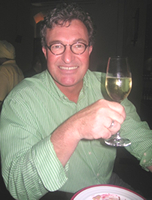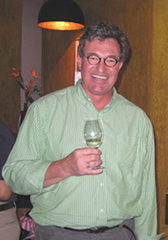|  What
is your current focus at Sula? What
is your current focus at Sula?
I am working with red grapes right now. As they say,
you can define great wine by your capability to make
red wine.
So that's how would you say Sula has been evolving?
Like the rest of the world, we planted white grapes
on the heavier soil and reds on the light and red soil.
Redder soils are light, yields are lower, retention
of water is low, berries are smaller and flavour is
better. We are slowly moving towards interesting reds.
How did you start with Zinfandel in Sula?
Rajiv and I brought cuttings of Zinfandel from a very
old clone of Old heritage Napa Valley vineyards in a
duffel bag in 1997. In fact, everyone else in Nashik
has used cuttings from this lot and what you see in
Zins, really originated from what we had brought together
from California.
How do you rate Sula's Zinfandel:
We are into third vintage (2007) now. The first one
was very small. I think we are coming along fine.
Isn't Zin known more for the blush or 'white
zinfandel?'
Actually, it depends a lot on the style. I make a lot
of Zin in California. It is very powerful and colourful.
We are changing the style a bit here. We are making
it fruit forward with a good mouthfeel in Nashik.
There was a talk of declaring Zin as a heritage
grape in California last year, no?
Zin is well thought of in California-it is our heritage
grape. There are sites that are ideal for Zin; warm
during day and cool at night. This gives spicy red berry
like fruit, the wine from which should be drunk young.
Some people believe Zinfandel when aged makes
fine wine. I tasted a 100- year Ironstone in Prowein
this year, still drinking well !
I am not a fan of ageing Zins. Beauty of Zin is in the
fruit. By ageing it for 10 years you may lose the fruit.
Subject to proper ageing, Zins give you nice spice and
at half the price of cabernets.
What kind of Zin does California produce?
While they make both red and white (white zinfandel
is slightly confusing-it means blush or Rose and is
processed as such and drunk cooled-edito r). In
the eighties and nineties white was quite popular. Now
it mirrors our emphasis and the preference is for red
Zinfandels.
How does Zin go with Indian food?
Rajeev and I have been to many Chefs. General feeling
is that whites go better with your food. Good acidity
with lots of brightness goes better with food. In Zin
and Shiraz the goal is to have fruit forward wine that
has youth on its side. Zin, Grenache and Merlot are
good wines with food. I don't think chardonnay with
too much of oak will go with Indian food. It is too
fat for your food.
We are also trying Viognier which I have not tasted.
It has a lot of litchi and apricot flavours. We have
produced very small quantities so far. When we come
in good production quantity, I think it will be a very
interesting food wine.
Would it be 100% Viognier , unlike Grover who
blend it with Clairette?
Oh, it will be 100% Viognier.
So many producers claim to make great wine in
the very first year. Doesn't the vine need a few years
to start giving fruit interesting for wines
It is true as a rule that the vine must be 3-5 years
old before it starts giving good fruit for wine. However,
I have produced some very good wine from even a 1-year
old vine. It depends on several factors to produce good
quality.
It is interesting to see you are working towards
Master of Wine. When did you enrol for it?
I enrolled in 2000 and am still going strong. I am soon
going for my first attempt.
Isn't your degree from the UC Davies enough
for what you are doing?
UC Davis from where I did my B.S in Fermentation Sciences
is great for graduation. It is a very academic institution.
However, MW gives you a very well rounded exposure to
all aspects of winemaking including enology.
Which are some of the more practical schools
for wine education?
I would recommend San Luis Obispo in California, Cornell
and Montpellier, France.
(It was after this interview that an MBA Wines programme
was announced by Sonoma University. This would be high
on the list of many Indians going abroad for an MBA,
keeping a future career in wines in mind-editor)
I notice you did some work in Lodi (low-die
) in Central California too. Doesn't it make low ended
bulk wines?
I did my initial stint in this area. Actually, this
area makes the best of Central Valley region wines which
are produced generally in the warm areas. Lodi is the
coolest area of Central Valley. It is not coastal but
for higher end wines from the region, grapes from ancient,
old vines are used in Lodi, giving better fruit and
wines. Sauvignon blanc and Zin are my favourites from
this region.
Is it true that you are trying to work towards
two crops a year in Sula?
Well, I do know that the experiment is going on. In
fact, last Christmas the first crop was harvested earlier
so the vines could be pruned and be ready for the next
crop to be harvested before the rains. Personally, I
am not happy about the concept. I am sure the quality
of the second crop will suffer.
What I would like to see is an early harvest, especially
for the grapes for sparkling wine giving us an opportunity
to use our winery facilities to a greater extent and
with more efficiently.
What do you see are the big challenges in the
Indian market?
For one, I see that proper storage temperature of wine
is very important. I see that the wine is stored at
high temperatures. No matter what we do in the winery,
if people don't store the wines properly, they will
not get the maximum enjoyment from our wines.
 And
where do you see sula heading? And
where do you see sula heading?
As I said in the beginning, we are concentrating on
red wines now. I think these are the future quality
wines and Sula will continue to strive for better quality.
You can ask Rajeev for the marketing projections.
Do you get paid for your consultancy in cash
or do you get shares of Sula instead?
I do already own some equity in my wife's name.
Do you make your own wine?
Yes, we have a small winery, Palmeri Wines where we
produce a small quantity. I spend a lot of my time in
consultancy.
Do you believe in the quality of terroir?
Definitely. Even my consultancy firm is known as Terroirs.
Nashik has a nice terroir.
How many clients do you have?
About 15.
Where do you consult?
I am working with people in California and Washington.
I am also involved in China and Bulgaria, besides India,
of course.
How often do you come to India?
I come at least once, sometimes twice. Rajeev comes
to the US fairly regularly too.
I am sorry I've gotta go now.
Thank you, Kerry.
My pleasure.
|